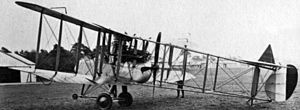Francis Cubbon facts for kids
Quick facts for kids
Francis Richard Cubbon
|
|
|---|---|
| Nickname(s) | Puddles |
| Born | 26 November 1892 London, England |
| Died | 9 June 1917 (aged 24) near Warneton, France |
| Commemorated at |
Arras Flying Services Memorial, Pas de Calais, France
|
| Allegiance | United Kingdom |
| Service/ |
British Army |
| Years of service | 1911–1917 |
| Rank | Captain |
| Unit | York and Lancaster Regiment 72nd Punjabis No. 20 Squadron RAF |
| Awards | Military Cross & Bar |
Francis Richard Cubbon (born November 26, 1892 – died June 9, 1917) was a brave aerial observer and a top pilot, known as a flying ace, during the First World War. He worked with different pilots and together they achieved 21 victories in air battles.
Contents
Early Life and Military Start
Francis Richard Cubbon was the only son of his parents to survive. His father, Captain Richard Cubbon, was an officer in the Indian Army.
Francis was born in London, England. However, he spent most of his childhood in Poona, India. He went to school at Alleyn's School and Dulwich College. After that, he studied at the Royal Military College, Sandhurst. This is a famous military academy.
In September 1911, Francis joined the Indian Army as a second lieutenant. His first job was with the York and Lancaster Regiment in Karachi. Later, in December 1912, he moved to the 72nd Punjabis in India's North-western Frontier. He was promoted to lieutenant in 1913 and then to captain in 1915. In November 1915, he had to return home because he was unwell.
Joining the Royal Flying Corps

Many soldiers who were sent home due to injury or illness during World War I chose to join the air force. Francis Cubbon was one of them. He volunteered for flight duty and became an observer on March 25, 1917.
By April 1917, a very tough month for pilots known as "Bloody April," he was part of 20 Squadron. He flew as an observer in Royal Aircraft Factory F.E.2 planes. These planes were quite old-fashioned.
Frederick Libby, who was the first American flying ace, described what it was like to be an observer in these planes:
When you stood up to shoot, all of you from the knees up was exposed to the elements. There was no belt to hold you. Only your grip on the gun and the sides of the nacelle stood between you and eternity. Toward the front of the nacelle was a hollow steel rod with a swivel mount to which the gun was anchored. This gun covered a huge field of fire forward. Between the observer and the pilot a second gun was mounted, for firing over the F.E.2d's upper wing to protect the aircraft from rear attack ... Adjusting and shooting this gun required that you stand right up out of the nacelle with your feet on the nacelle coaming. You had nothing to worry about except being blown out of the aircraft by the blast of air or tossed out bodily if the pilot made a wrong move. There were no parachutes and no belts. No wonder they needed observers.
Libby also mentioned that there was a danger of falling out of the plane and hitting the propeller!
Cubbon achieved his first two victories on April 24, 1917. He was flying with Lieutenant R. E. Johnson in an F.E.2 plane. After that, he flew with Captain Frederick Thayre for about six weeks. Together, they claimed an amazing nineteen more victories.
Seventeen of these victories were against German Albatros D.III fighter planes. After Captain Albert Ball died on May 7, Cubbon became the second-highest scoring ace in the Royal Flying Corps.
Killed in Action
On June 9, 1917, just two days after their last victory together, Cubbon and Thayre were flying. They attacked a German Albatros two-seater plane and watched it crash in a smoking nose dive. Soon after, their own plane was hit directly by anti-aircraft fire from a German battery near Warneton. Both Cubbon and Thayre were killed.
The German army sent a message to the British to confirm their deaths. However, their graves were never found.
The nineteen victories Cubbon shared with Thayre included five Albatros D.IIIs shot down in flames and eleven destroyed. They also destroyed an Albatros reconnaissance plane in flames and another one. One more D.III was forced down "out of control." Cubbon also had his two victories with Johnson: one D.III destroyed and another "out of control."
Cubbon received the Military Cross on May 11. He also received a Bar, which means a second award, on May 16. Both awards were officially announced after his death on July 18, 1918.
Awards and Decorations
- Military Cross
- Captain Francis Richard Cubbon, Indian Army, attached to the Royal Flying Corps.
- This award was for his outstanding bravery and dedication to duty. He showed great courage and determination as an observer. On many occasions, he displayed excellent shooting skills and calmness even when facing more enemy planes.
- Bar to the Military Cross
- Captain Francis Richard Cubbon, MC, Indian Army, attached to the Royal Flying Corps.
- This second award was also for his outstanding bravery and dedication to duty. When he was an observer on a patrol, he showed great skill and courage against more enemy planes. Throughout the battle, he supported his pilot with amazing marksmanship.


